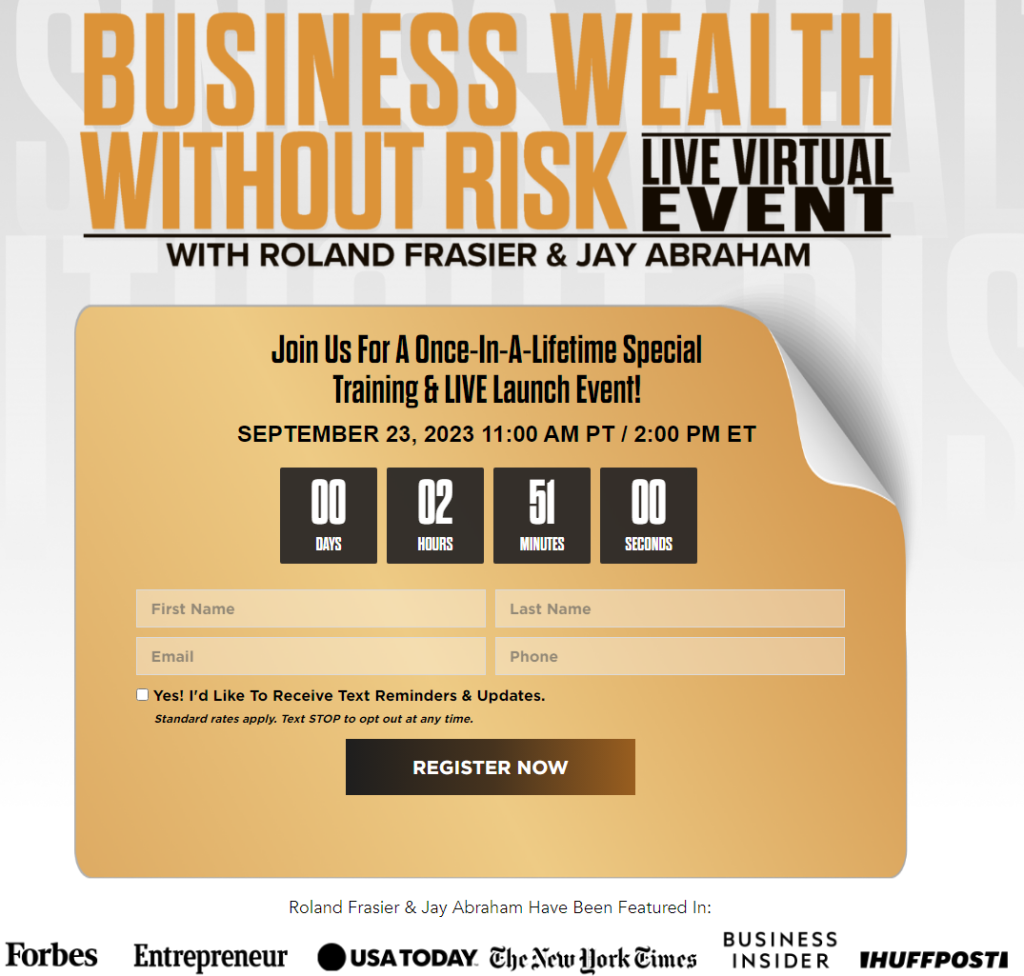We’ve all heard the adage “No risk, no reward.” In business, where every decision can either make or break an enterprise, it’s almost a given that risk is inherent. However, an intriguing discussion has been around an event called “Business Wealth Without Risk.” Let’s delve into this concept and understand whether it’s a fleeting fad or a genuinely viable strategy.
What is “Business Wealth Without Risk?”

In the dynamic landscape of entrepreneurship and corporate ventures, the phrase “No risk, no reward” often reverberates as a core principle. Yet, the idea of “Business wealth Without Risk” has been making waves in recent discussions. What does it mean, and is it even feasible? Let’s delve deeper into this intriguing concept.
Understanding “Business Wealth Without Risk”
At its core, “Business Without Risk” doesn’t necessarily imply the complete absence of risk. Instead, it accentuates the importance of minimizing, managing, and mitigating risks businesses face.
1. Minimizing Risks:
It entails adopting strategies and decisions that inherently carry lower risk. It could mean opting for tried-and-true business models, targeting more stable markets, or avoiding highly speculative ventures.
2. Managing Risks:
Risk management involves identifying potential threats and implementing procedures and strategies to address them. It can include insurance, diversifying assets, or creating contingency plans.
3. Mitigating Risks:
Once risks materialize, businesses need effective ways to lessen their impact. It could be through rapid response teams, effective PR, or leveraging technology to address challenges.
The Driving Forces Behind the Concept
Several modern factors underscore the growing allure of a “Business Without Risk” model:
- Technological Advancements: With the rise of AI-driven analytics, predictive modelling, and comprehensive data analysis, businesses can now predict potential pitfalls more accurately than ever before.
- Globalization: In today’s interconnected world, the ripple effects of events in one corner of the globe can impact businesses elsewhere. This makes the ability to forecast and manage risks even more crucial.
- Consumer Expectations: In an era of instant information, consumers are less forgiving of mistakes. Businesses need to be proactive, not just reactive, to maintain their reputation.
Is True “Business Without Risk” Possible?
While the idea is alluring, we must ground our expectations in reality. Complete elimination of risk is a utopian ideal. Every decision in business, from launching a new product to entering a new market, carries inherent risks.
However, what “Business Wealth Without Risk” indeed promotes is a shift in mindset. It urges businesses to be more calculated, to leverage modern tools at their disposal, and to always be a step ahead in anticipating challenges.
The Event That Sparked Discussion
A recent event titled “Business Wealth Without Risk” brought together some of the brightest minds in finance, strategy, and management. They discussed various tools, technologies, and methodologies that allow companies to operate with a minimized risk profile. Some key takeaways from the event included:
- Embracing Technology: Modern businesses have various technological tools like AI-driven risk analysis, predictive modelling, and data analytics. These tools allow businesses to predict potential pitfalls and prepare in advance.
- Flexibility and Adaptability: The ability to pivot in response to unforeseen circumstances can significantly reduce risk. Businesses that are rigid in their strategies often find themselves more exposed.
- Diversification: Diversifying revenue streams, customer bases, or product lines can act as a buffer against market fluctuations. It’s the age-old advice of not putting all your eggs in one basket.
- Education and Continuous Learning: One of the best ways to mitigate risk is to be well-informed. Keeping abreast of industry trends, market shifts, and global events can give businesses a competitive edge.
Can Businesses Truly Operate Without Risk?
Risk and business. These two concepts have danced hand in hand since the inception of trade. But as our world becomes more unpredictable and complex, the question arises: Can businesses truly operate without risk? Let’s explore this notion and what it implies for today’s entrepreneurs and corporations.
Defining Risk
At its core, risk refers to the potential for unforeseen adverse outcomes in the face of uncertainty. In business, this might manifest as financial losses, reputational damage, operational failures, or numerous other challenges.
Inherent Business Risks
Every phase of business, from inception to maturity, is laden with risks:
- Startup Phase: New companies grapple with market acceptance, potential cash flow issues, and establishing a reliable supply chain.
- Growth Phase: As businesses expand, they face risks such as over-extension, increased competition, and scalability challenges.
- Maturity and Decline Phase: Established businesses might face risks of stagnation, technological obsolescence, and changing consumer preferences.
Modern Risk Factors
Today’s businesses also grapple with a set of modern risks:
- Technological Risks: With the rapid evolution of technology, there’s the risk of data breaches, cybersecurity threats, and the challenges of keeping up with tech advancements.
- Globalization and Geopolitical Risks: International businesses face geopolitical tensions, currency fluctuations, and regulatory environments.
- Environmental and Social Risks: The increasing emphasis on sustainability and social responsibility means businesses now face risks related to environmental impact, social governance, and more.
Risk Elimination vs. Risk Management
The simple answer to the central question is no; businesses cannot operate without risk. Risk is an inherent part of the decision-making process. However, there’s a significant difference between risk elimination and risk management.
- Risk Elimination: Completely avoiding risk would mean stagnation. Businesses would never innovate, expand, or even make fundamental decisions for fear of the unknown. In essence, the act of doing business is itself a risk.
- Risk Management: This is about understanding, measuring, and mitigating risks. It’s a proactive approach, where businesses prepare for potential pitfalls and have strategies to address them. With tools like data analytics, predictive modelling, and comprehensive risk assessment strategies, companies can manage and leverage risks for competitive advantage.
Conclusion: A Balancing Act
The quest for a risk-free business might be a modern-day myth, but what isn’t mythical is the possibility of strategically minimizing it. By integrating technology, promoting adaptability, diversifying assets, and emphasizing continuous learning, businesses can enter a future with greater control over uncertainties.
To paraphrase a famous saying, “There might be no business without risk, but there’s smart business with managed risk.” It’s time for entrepreneurs and business leaders to shift their perspectives and see risk as a challenge and an opportunity to demonstrate strategic prowess.
If you are looking for business wealth without risk, click here to learn everything you need to know about business wealth without risk
Some links in this article may be affiliate links, meaning they could generate compensation to us without any additional cost to you should you choose to purchase a paid plan. These are products we have personally used and confidently endorse. It’s important to note that this website does not offer financial advice. You can review our affiliate disclosure in our privacy policy for more information.




